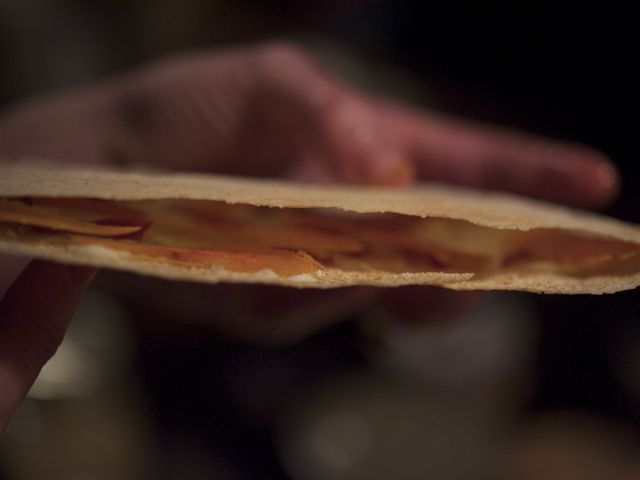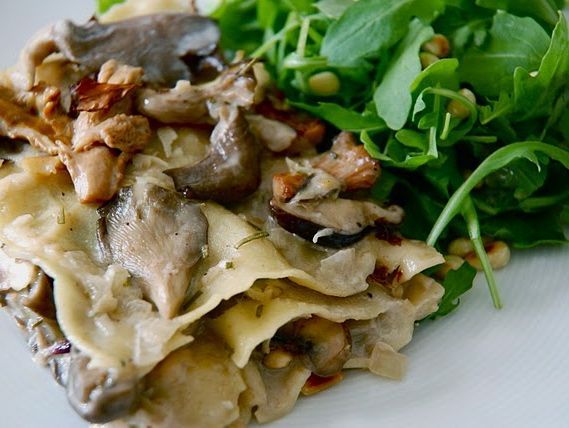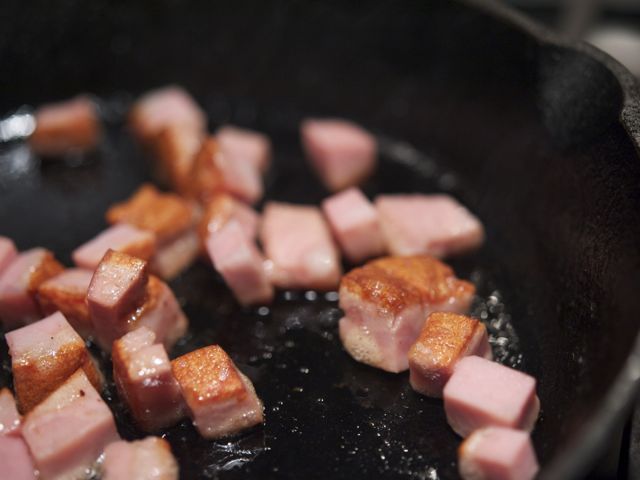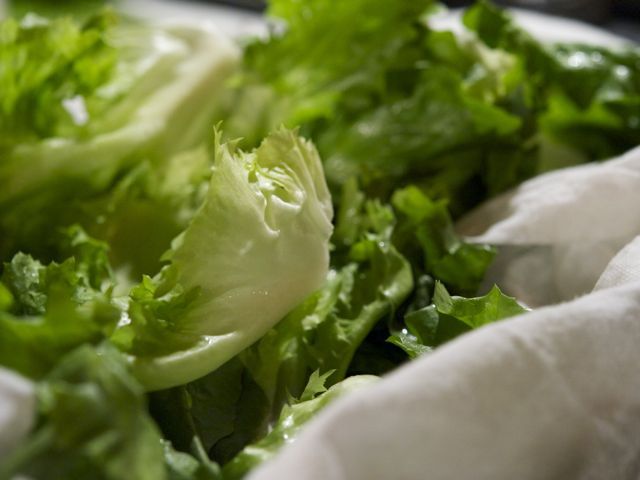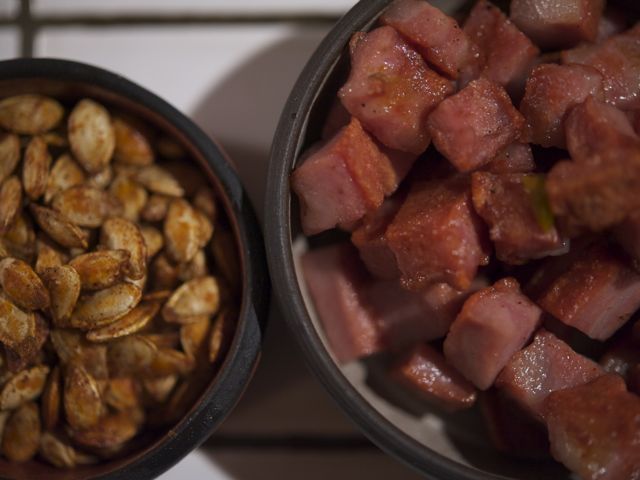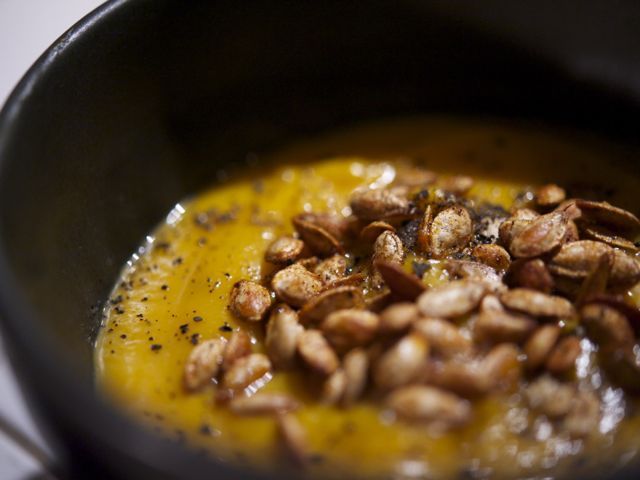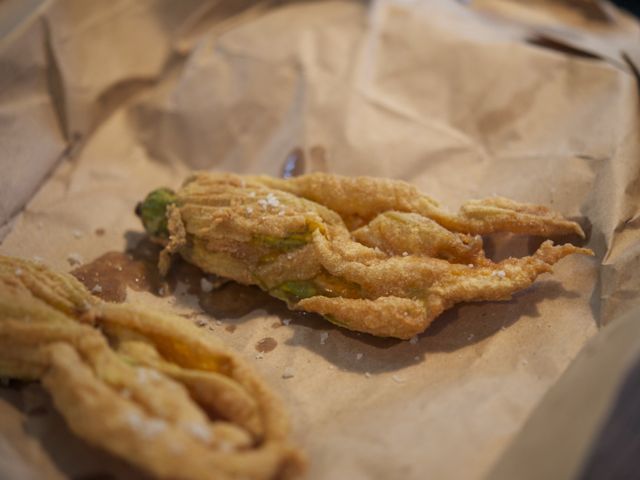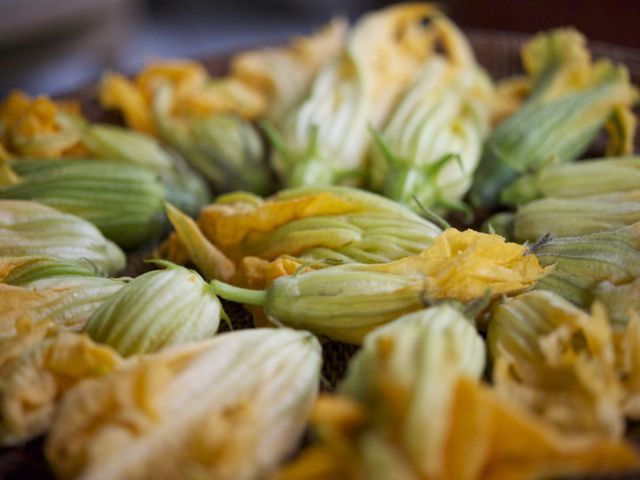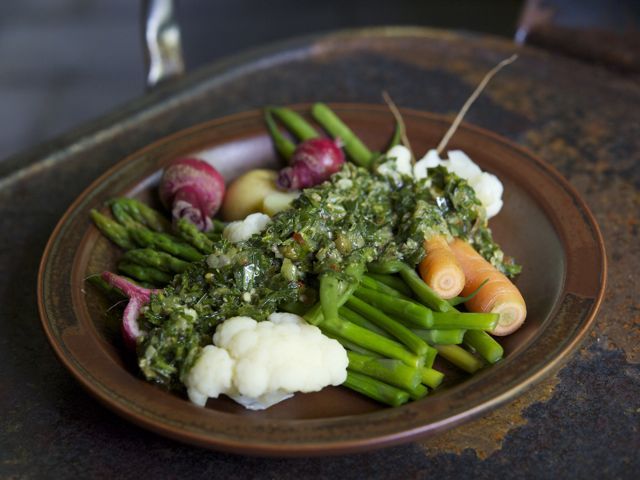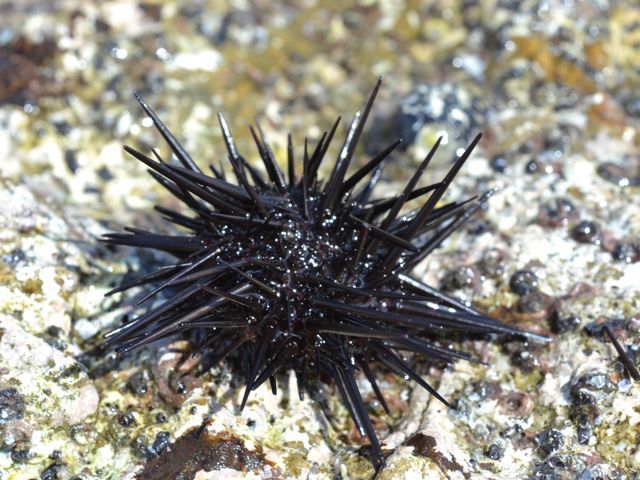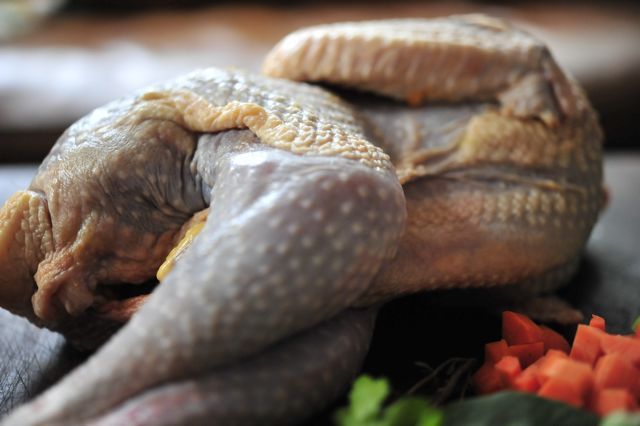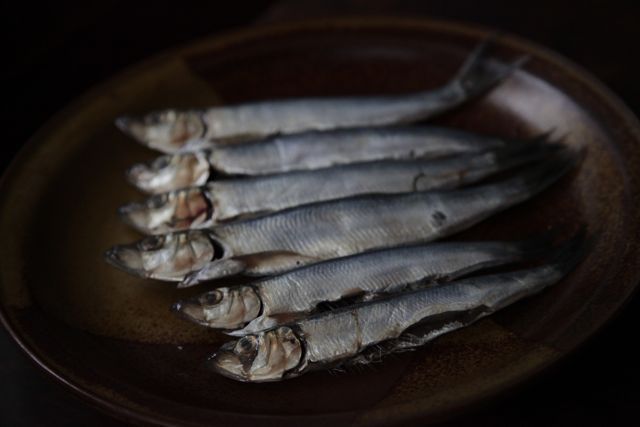Not a lot of cookies get baked in this house. What with the chubbiness issue and the gluten factor, desserts, at this point, when they're even offered, tend to run more towards that chia pudding, a refreshing scoop of sorbet, some gussied-up tofu or simply a piece of seasonal fruit. Occasionally, however, the imminent arrival of company or some other deserving event does give rise to a batch. A good gluten-free cookie is almost as elusive as a good man. For a time, our cookie jones was sated by Whole Foods' house brand, which included a chewy ginger-molasses, a rich and crumbly peanut butter and the highly coveted nutmeal-raisin, but for some reason these disappeared from their shelves never to return. The (faux-helpful) staff tried to gaslight me when I asked about them, acting as though these divine confections had never existed. I vowed to G that I would try my hand at my own version of the nutmeal cookie, but so far I have not been true to my word.
Read More...
Twitter @glutton4life
12.28.11 Roe, Roe, Roe
I saw an article recently on NPR’s food blog that pointed to the way North American cooks rely on flavors that are related, while East Asians go for sharp contrasts. The former tend toward things like milk, egg, butter, cocoa, and vanilla, while the latter combine foods like shrimp, lemon, ginger, soy sauce and hot peppers. I prefer to have one foot planted in each camp and, if I had to choose, would be the exception that proved the North American rule. Unlike so many other blogs and cooking resources out there, I don't rely so heavily on "comfort food." Sometimes I think that's just a euphemism for bland and fattening. I love bold, sharp flavors and ringing contrasts in texture and taste. Even yesterday's scourtins, buttery as they are, have the salty, bitter kick of black olives. Assertive flavors can really get under your skin (your tongue?). Ever since I ordered this crazy fish roe sandwich at The John Dory, it's spicy-salty-umami deliciousness had haunted me, and I became determined to recreate it in my own kitchen. Turns out chef April Bloomfield first tried this simple snack at the home of Italian culinary legend Marcella Hazan and she, too, was intrigued.
Read More...
Read More...
12.20.11 Lusty Lasagna
My friend Jim has been chomping at the bit for this mushroom lasagna. I mentioned it in passing on my GFL Facebook page (Still haven't "liked" me yet? Hustle over there and help me boost my numbers, yo!) and he started drooling and envisioning a cozy Christmas Eve gathering with this as the irresistible centerpiece. Never mind that I basically kiped the recipe from a recent article in the New York Times in which editor Sam Sifton waxed eloquent about "a gooey thrill of savory sweetness, salty astringency and the meaty pong of wild mushrooms"—a lasagna made by Monica Byrne of Brooklyn's Home/Made. Sifton adapted her recipe for home cooks with a few shortcuts, including no-boil noodles, and I adapted it further to use what I had on hand. Living in the sticks, you can't just run out to the corner store for a ball of smoked mozzarella or some truffle oil whenever the whim strikes. But one of the many beauties of lasagna is that it's pretty forgiving, as long as you're using a light touch and very fresh ingredients, whatever they may be. Personally, I'm not the biggest fan of those leaden layers with all kinds of meat and sausage and an overly seasoned tomato sauce. But this recipe eschews meat altogether in favor of radicchio (though I could definitely see adding in some pancetta or bacon), and the sauce is a garlicky béchamel. It's a rich and creamy dish that's pretty much exactly what you want for dinner on Christmas Eve—unless you're making tamales. Or duck. Or paella, which is what I'll be eating on the 24th.
Read More...
Read More...
11.30.11 My Baloney
My baloney has a first name. It's Mortadella. I'll bet you already know that baloney is a bastardization of bologna—actually, Bologna, for the city in Italy from whence this delectable pork sausage hails. But are you aware that it's named for the mortar (mortaio) that in conjunction with a pestle was originally responsible for the finely ground meat that forms the basis of this heat-cured salume? (Salume is how Italians refer to charcuterie or, more basely, cold cuts.) I have no love for Oscar Mayer's offspring, and shudder to think what goes into those inspid, rubbery slices. They're barely fit to kiss the hem of the real deal: a rich, dense and savory concoction, flavored with garlic, coriander, nutmeg and sometimes studded with pistachios.
I get my mortadella at Eataly's fabulous salumeria where I can have it cut to order in a thick slab. For some gathering over the next month I may even make this recipe I came across for "Mortadella Smear" in Saveur. Trust me, it surpasses its unfortunate name in every way. Pureed mortadella enriched with a velouté sauce and a little cream, slathered on grilled bread and drizzled with balsamic. What's not to like? This diverges wildly from the mortadella of yore and is more akin to paté whipped up by a lazy Italian contessa.
Mortadella has a fair amount of fat, so it fries up beautifully crisp. You can do thin slices, which are quite nice, almost chip-like, but I prefer chubby little cubes that come out chewy with crunchy edges. The perfect vehicle for them? A fresh escarole salad tossed with tangy anchovy dressing.
Escarole, also known as "broad-leaved endive" (but not called that by anyone you know) is a member of the chicory family, along with puntarelle, radicchio and Belgian endive. It's slightly sweeter than its bitter brethren and is a sadly under-appreciated green. (Here's a recipe for a very simple escarole soup.) Delicious cooked—sauteed with shallots and chile, wilted in garlicky oil—escarole is secretly a salad diva. Served raw, it's gutsy without being aggressive and has gently curled edges that are made for cupping dressing.
We had this salad one night for dinner along with cups of creamy butternut squash soup sprinkled with spicy toasted squash seeds, and it reminded me that I've been meaning to talk to you about something: GARNISHES. The way you finish a dish can make the difference between good and extraordinary. G calls it "kicking it up a notch"—unabashedly ripping off Emeril's catch-phrase—and it's a call to action in the kitchen. You can always make something just that much better with an extra drizzle of spicy green olive oil, sprinkling of coarse sea salt, frizzle of herbs or dollop of crème fraîche.
This is where the notion of condiments comes into play. Homemade chutney, spiced pumpkin seeds, curry salt, fried sage, pickled onions—these have the power to bring your cooking into focus by adding flavor and textural counterpoints. Use your imagination, your creativity and your palate, and have fun gilding the lily.
Read More...
Read More...
9.27.11 Flower Child
Squash blossoms are delicate and ethereal, yet somehow sturdy enough to stand up to a good frying. They're delicious other ways, too, as in this fresh vegetable stew from Mexico, full of flores de calabaza, chiles and herbs. You'll find them fried all over Italy where they're known as fiori di zucca, always battered and sometimes stuffed. One classic version calls for a stuffing of anchovy filets and mozzarella, but mine—herb-flecked goat cheese—is lighter and feels a bit more in tune with these days of Indian summer. Like most fried foods, they're best served fresh from the oil, so they're really not the thing for a big party. But it's lots of fun to fry up a dozen or two for a group of friends gathered in the kitchen, sipping prosecco or rosé and singing the chef's praises. I can't remember where I learned to use masa harina for these, but I'm always on the lookout for gluten-free substitutes for wheat flour. As with my fried calamari, rice flour would probably work well, though the understated corn flavor of the masa harina really does seem to complement the subtle, sweetly vegetal note of the squash blossoms. By the way, zucchini flowers are said to be better than those of yellow squash, which can get slightly bitter. Choose the freshest, perkiest ones you can find. They need to be slightly open. Too tight and the fragile petals will tear as you attempt to pipe in the filling. Ain't that always the way?
Read More...
7.7.11 Secret Sauce
Salsa verde has more than one guise. In Italy it is a cold rustic sauce vaguely resembling a pesto of sorts but very light, fresh and tangy. Generally it features parsley, capers, onion, garlic, anchovies, vinegar, olive oil and lemon, but may also contain a bit of crumbled white bread, pickles, mustard and other green herbs. It's an opportunity for you to experiment a bit and make it as you like. This is most definitely not the salsa verde you would find in a Mexican restaurant. That one contains tomatillos and chiles and is a whole other conversation; or post, as the case may be. Nor is it quite the same as Argentina's famed chimichurri, which is missing the umami wallop of anchovy. Incidentally, if you still think you don't like anchovies and you leave them out of this sauce, you will be depriving yourself of a great taste sensation. I understand how you might be turned off by the little oily fillets with their hairy-looking bones and fishy aroma, but once they become part of something else—a Caesar dressing, say, or this sauce—they lose their identity and simply impart a rich depth of flavor that is like nothing else. Not to mention they're really good for you. So, salsa verde: the perfect summer sauce to slather on everything grilled, from fish and shrimp to chicken and steak. My other favorite way to eat it? As a dip for garden-fresh raw or lightly blanched vegetables.
Read More...
Read More...
6.17.11 Father Time
My father died more than 20 years ago, long before his time. The moment of his death is still very clear in my mind. Later I sat with my mother in the upstairs hall, both of us in our nightgowns, averting our eyes as they brought him out in a dark green body bag. I can't say those images have faded, but they are often crowded out by happier thoughts of him as he was in life: the consummate prankster, a sly grin twisting his mouth, a deeply compassionate man, a generous spirit, a scholar. As Father's Day approaches, I long to tell him what has become of me, to seek his approval. Some things never change. He was most often at his desk, talking on the phone with colleagues, proofing manuscripts, scribbling away with the tiny pencil stubs he favored. Intrusions were not wholly unwelcome, especially if you came bearing a small snack. He loved nuts. His favorites were cashews, pistachios, peanuts and Spanish almonds; also hard licorice, chicharrones and chicken liver. In his honor, I post again my recipe for Tuscan chicken liver paté—a shout-out to both his humble Jewish roots and his later-acquired European sophistication.
Read More...
Read More...
4.20.11 Sea Delicates
A month or so before we got married in October of 2007, G whisked me off to Turkey for a quick getaway. Although we had big plans to travel around and see lots of sights, after a couple of days in Istanbul we found ourselves holed up in the unbelievably charming Hotel Ada in Turkbuku, in the hills above Bodrum, with absolutely no desire to go anywhere else. This gorgeous stone hotel is built around several 150-year-old olive trees, has a lovely hammam for bathing and steams, and is beautifully furnished in a warm and eclectic style. Our room had stunning views of the Aegean and a private pool where we sunned and swam every day. We breakfasted on juicy peaches and sweet figs on our balcony; lunched on fresh salads and icy cold watermelon juice by our pool; and dined in bed on just-caught seafood. G was especially taken with a pasta dish piled high with what they called "sea delicates"—little scallops, shrimp, squid and fish in a tomatoey sauce. At the time, he did not know that gluten was a big problem for him, so this was truly an instance of ignorance being bliss. Ditto the molten chocolate cake he had for dessert every night.
Read More...
Read More...
3.2.11 The Skinny on Guinea
In my quest to revisit the culinary tropes of winter one last time before the change of season, it's time for braising. There's nothing cozier than a pot of something bubbling gently on the stove (or in the oven) all day long, and it's a good idea to enjoy the warm, tender, hearty results now, as they're a far cry from what we'll be craving when the mercury rises. So before we're on to spring's sweet pea risotto and asparagus soup and pickled ramps, are you sure you've perfected the art of the braise? It's all about low and slow, gentle heat breaking things down and building rich, complex flavors. Turns out it's the perfect way to cook a guinea hen (also known as guineafowl). Never had one? Tastes like chicken. Seriously, this is one gorgeous bird, with its dappled black and white feathers and tiny little head. As you can see, above, its meat is darker than a chicken's but it's nowhere near as assertive in flavor as a pheasant or grouse. It's quite high in protein, but doesn't have much fat, which makes it a great candidate for braising.
1.25.11 Fish Tales
Sardines are like the girl who is considered frumpy and uninteresting in high school, and then suddenly becomes a hot anchorwoman or a triathlete. Familiar but surprising. They've always been there, hanging out in the cupboard in their dusty can with the peeling label, but guess what? It's time to tuck in to those silvery little fish. They've got game. Because they occupy the bottom of the aquatic food chain and feed solely on plankton, sardines don’t carry the high concentrations of heavy metals and contaminants that other fish can. And they're brimming with nutrition. Not only that, they've got culinary cred. Gabrielle Hamilton, the chef of Prune, in New York City, serves canned sardines on Triscuits with Dijon mustard and cornichons. She swears by the Ruby brand from Morocco. I've had good luck with Matiz Gallego from Spain, Angelo Parodi from Portugal and Bar Harbor from Maine. For other recommended brands, see here.
Read More...
Read More...









